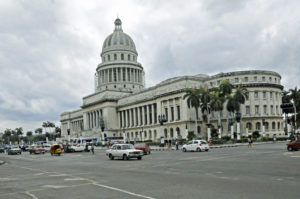
El Capitolio in Havana, Cuba (Photo by Don Knebel)
In 1925, after a period of political instability and financial distress, during which the United States repeatedly intervened to protect its interests, General Gerardo Machado, a hero of Cuba’s independence movement against Spain, became President. Machado immediately set out to make Cuba the Switzerland of the Americas, attractive to visitors from around the world. As one of many public works projects he initiated, largely financed by American banks, Machado engaged Cuban architect Eugenio Rayneri Piedra, the first graduate of Notre Dame’s School of Architecture, to design a home for the legislature to communicate a new image for Cuba. To connote democracy and stability, Rayneri based the essential look and scale of the building on the United States Capitol. To connote European sophistication, he copied the dome of the Paris Pantheon. Other design elements were adopted from Cuban colonial buildings. An estimated 5000 laborers, working around the clock, completed the 681-by-300 feet building, named El Capitolio, in just over three years. The elegant interior included the third largest indoor statue in the world and a 25-carat diamond marking the center of the Cuban coordinate system. The Cuban legislature began meeting in its imposing new home on February 24, 1931.
When the revolutionary government of Fidel Castro gained control of Cuba in 1959, it abolished the legislature. El Capitolio became the home of the Ministry of Science, Technology and the Environment. In 2013, Raúl Castro authorized an extensive renovation of a badly deteriorating El Capitolio to become home in 2018 to the Cuban National Assembly, established in 1976.
Comments are closed.